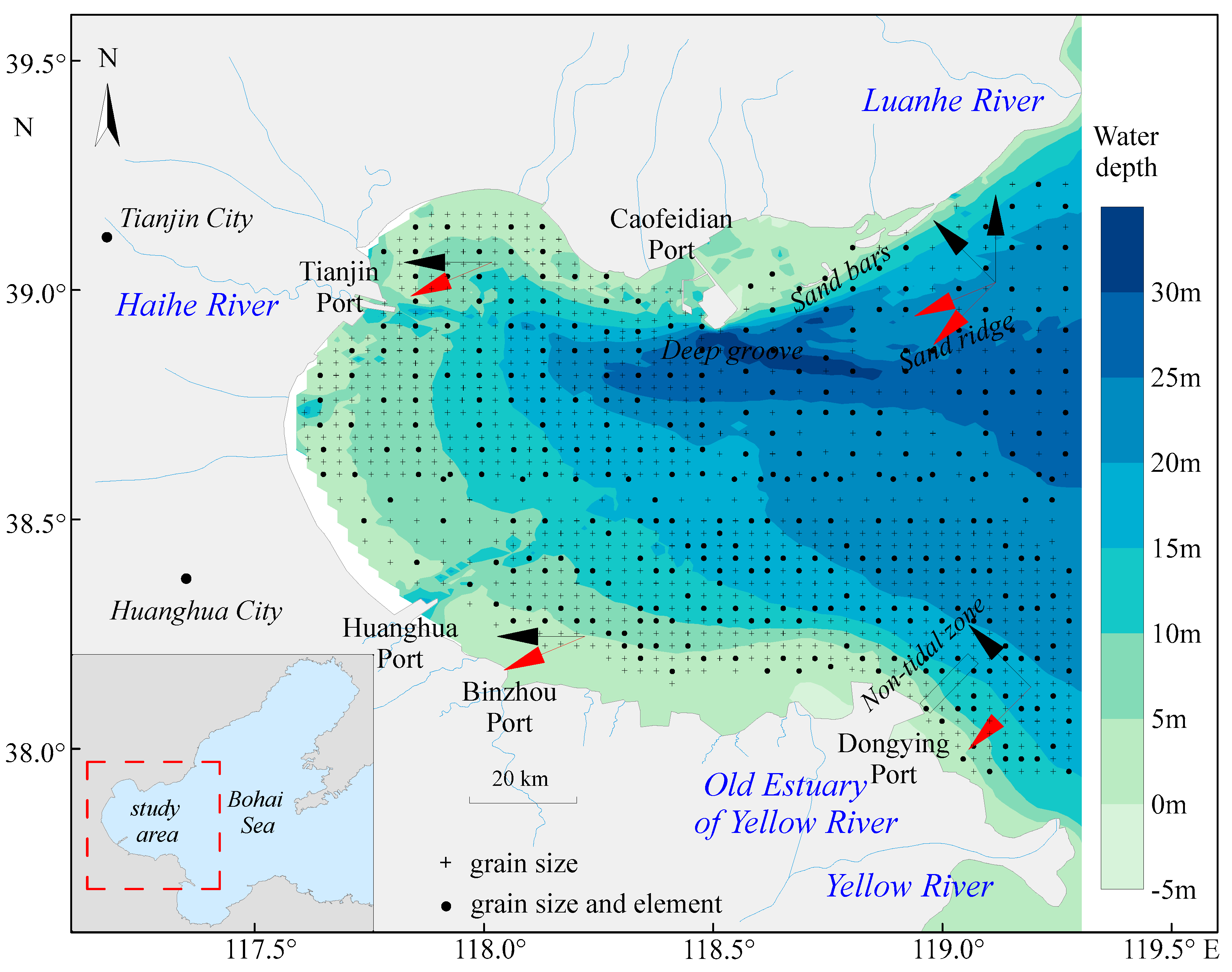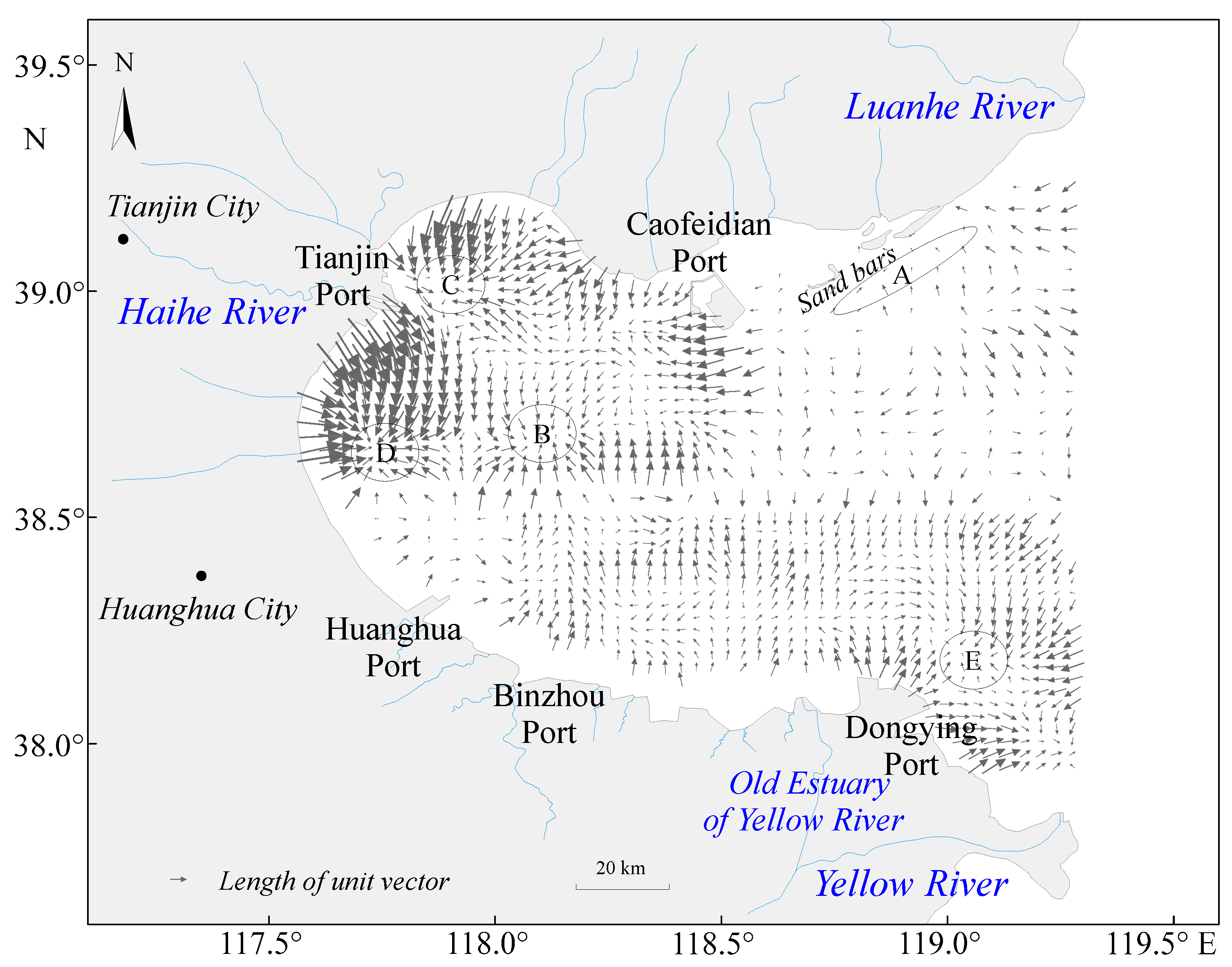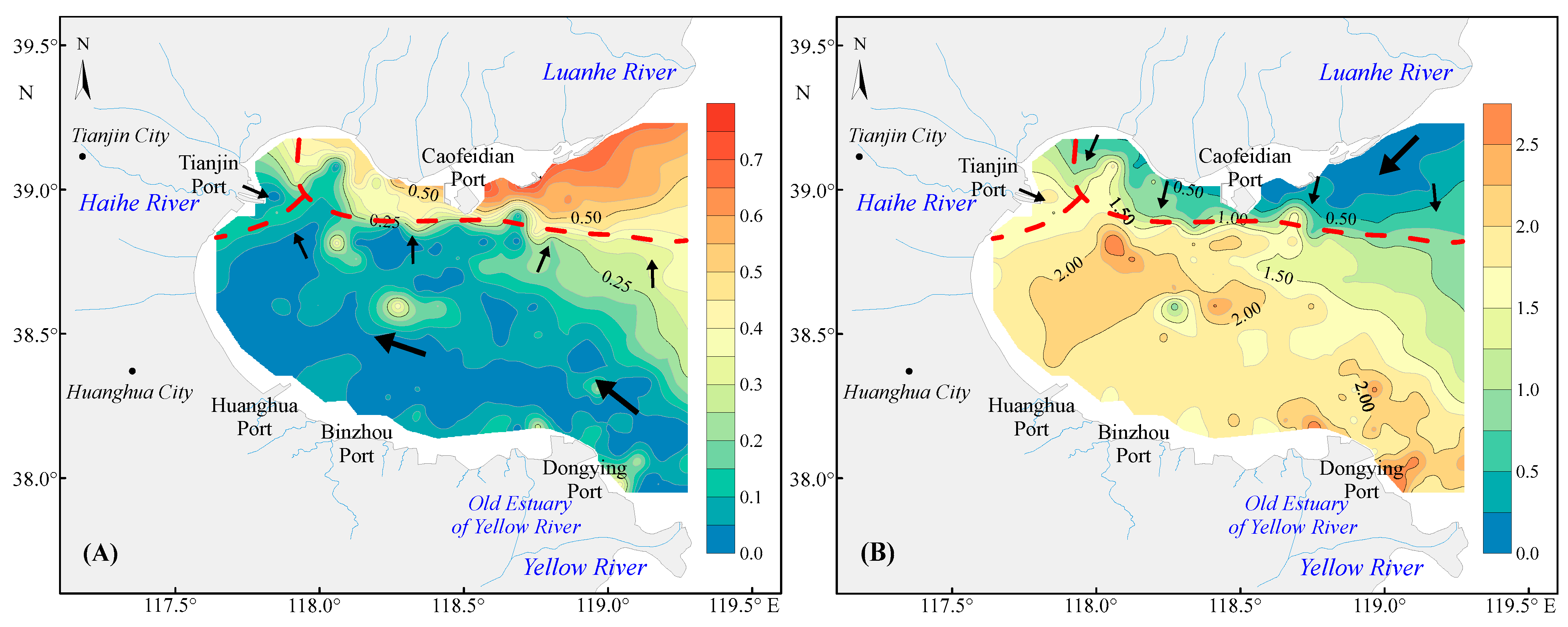Migration and Diffusion of Surface Sediments in Bohai Bay: Evidence from Grain Size and Elements
Abstract
:1. Introduction
2. Materials and Methods
2.1. Study Area
2.2. Sample Collection and Testing
2.3. Grain Size Trend Analysis (GSTA)
2.4. Discriminant Function (DF) Analysis
3. Results
3.1. Grain Size Trends
3.2. Distribution of Discriminant Function Indicator
4. Discussion
4.1. River Contribution and Sediment Diffusion
4.2. Coastal Erosion and Shoreline Retreat
4.3. Relationship between Sediment Transport and Ocean Dynamics
4.4. Impact of Sediment Transport on Offshore Oil Extraction
5. Conclusions
- 1
- The results of grain size trend analysis showed that coastal sediment in Bohai Bay is generally removed from the coast, which is consistent with the widely observed shore retreat.
- 2
- Discriminant function (DF) index based on Ca/Al can indicate the sediment contribution of the Yellow River and Luanhe River to Bohai Bay. Materials from the Yellow River dominated southern, western and central Bohai Bay, while materials from the Luanhe River dominated northeast Bohai Bay. The DF analysis indicated that the dominance of the Yellow River source was greater than previously thought, and the influence boundary between the Yellow River and Luanhe River is estimated to be at 38°50′ N. The influence of the Haihe River source is limited to the west of 118° E.
- 3
- With the diversion of the Yellow River channel and the reduction of material feed into the sea, sediment transport in Bohai Bay is now controlled mainly by marine dynamic processes. In both south and north Bohai Bay, sediment was transported into the Bay under the influence of constant wave directions, strongest wave directions and tidal residual currents. The central sea area and the underwater bank slope along the west coast of Bohai Bay have become the main sink areas of sediment. The coast has become an important source of sediment in Bohai Bay, and the source is higher up to include the coast itself.
Author Contributions
Funding
Institutional Review Board Statement
Informed Consent Statement
Data Availability Statement
Acknowledgments
Conflicts of Interest
References
- Wu, X.; Bi, N.; Xu, J.; Nittrouer, J.A.; Yang, Z.; Saito, Y.; Wang, H. Stepwise morphological evolution of the active Yellow River (Huanghe) delta lobe (1976–2013): Dominant roles of riverine discharge and sediment grain size. Geomorphology 2017, 292, 115–127. [Google Scholar] [CrossRef]
- Li, J.; Kang, H.; Wang, H.; Pei, Y. Modern geological action and discussion of influence facters on the west coast of Bohai Bay, China. Geol. Surv. Res. 2007, 30, 295–301. [Google Scholar]
- Qin, Y.; Zhao, Y.; Zhao, S. Geology of the Bohai Sea; Science Press: Beijing, China, 1985. [Google Scholar]
- Han, Z.; Zhang, J.; Zou, H.; Yi, W.; Li, M. Characteristics and provenance of clay mineral assemblage of sediments from the northern part of the Bohai Bay. Period. Ocean Univ. China 2011, 41, 95–102. [Google Scholar]
- Zhang, A.; Liu, M.; Liao, Y.; Zhang, Y.; Fan, D. The sedimentary geochemical trace of the Yellow River sediments diffusion in the Bohai Bay. Adv. Mar. Sci. 2015, 33, 246–256. [Google Scholar]
- Qin, Y.; Mei, X.; Jiang, X.; Luan, X.; Zhou, L.; Zhu, X. Sediment provenance and tidal current-driven recycling of Yellow River detritus in the Bohai Sea, China. Mar. Geol. 2021, 436, 106473. [Google Scholar] [CrossRef]
- Li, G.; Yue, S.; Zhao, D.; Sun, Y. Rapid deposition and dynamic processes in the modern Yellow River Mouth. Mar. Geol. Quat. Geol. 2004, 24, 29–36. [Google Scholar]
- Li, G.; Tang, Z.; Yue, S.; Zhuang, K.; Wei, H. Sedimentation in the shear front off the Yellow River mouth. Cont. Shelf Res. 2001, 21, 607–625. [Google Scholar] [CrossRef]
- Wang, H.; Yang, Z.; Bi, N. 3-Dsimulation of the suspended sediment transport in the Yellow River mouth I: Shear front off the Yellow River mouth. J. Sediment Res. 2006, 2, 1–9. [Google Scholar]
- Jia, Y.; Ke, X.; Xu, Y.; Wang, Y. Sedimentary transport trends of within a sand bar/lagoon system in the Bohai Sea. Mar. Sci. 1999, 3, 56–59. [Google Scholar]
- Zhao, B.; Zhuang, G.; Cao, D.; Lei, F. Circulation, tidal residual currents and their effects on the sedimentations in the Bohai Sea. Oceanol. Limnol. Sin. 1995, 26, 466–473. [Google Scholar]
- Zhang, Y.; Li, F. The characteristics of material component and the material resources in Huanghe (yellow) River, Luanhe River. Mar. Sci. 1983, 7, 15–18. [Google Scholar]
- Wang, Y. Analysis of Sediment Characteristics in the Tail Section of Haihe River and Compared with the Tail Section of Yellow River. Master’s Thesis, Ludong University, Yantai, China, 2017. [Google Scholar]
- Yang, Z.; Ji, Y.; Bi, N.; Lei, K.; Wang, H. Sediment transport off the Huanghe (Yellow River) delta and in the adjacent Bohai Sea in winter and seasonal comparison. Estuar. Coast. Shelf Sci. 2011, 93, 173–181. [Google Scholar] [CrossRef]
- Wang, P.; Zhang, L.; Lin, X.; Yan, J.; Zhang, P.; Zhao, B.; Zhang, C.; Yu, Y. Spatial distribution, control factors and sources of heavy metal in the surface sediments of Fudu Estuary waters, East Liaodong Bay, China. Mar. Pollut. Bull. 2020, 156, 111279. [Google Scholar] [CrossRef] [PubMed]
- Mcmanus, J. Grain size determination and interpretation. In Techniques in Sedimentology; Tucker, M.E., Ed.; Blackwell Scientific Publications: Hoboken, NJ, USA, 1988. [Google Scholar]
- Gao, S. A Fortran program for grain-size trend analysis to define net sediment transport pathways. Comput. Geosci. 1996, 22, 449–452. [Google Scholar] [CrossRef]
- Gao, S.; Collins, M.B. Analysis of grain size trends, for defining sediment transport pathways in marine environments. J. Coast. Res. 1994, 10, 70–78. [Google Scholar]
- McLaren, P. An interpretation of trends in grain size measures. J. Sediment. Petrol. 1981, 51, 611–624. [Google Scholar]
- McLaren, P.; Bowles, D. The effects of sediment transport on grain-size distributions. J. Sediment. Petrol. 1985, 55, 457–470. [Google Scholar]
- Poizot, E.; Méar, Y.; Biscara, L. Sediment Trend Analysis through the variation of granulometric parameters: A review of theories and applications. Earth-Sci. Rev. 2008, 86, 15–41. [Google Scholar] [CrossRef]
- Lan, X.; Zhang, X.; Zhao, G.; Zhang, Z. REE distributions and provenance discrimination of sediments from South Yellow Sea. Geochimica 2009, 38, 123–132. [Google Scholar]
- Yang, Z.; Wang, Z.; Ju, J.; Zheng, A. Study on carbonates from the coastal zone of the Yellow River Delta and adjacent Bohai Gulf. J. Ocean Univ. Qingdao 1989, 19, 91–99. [Google Scholar]
- Zhao, Y.; Yan, M. Geochemistry of China’s Shallow Sea Sediments; Science Press: Beijing, China, 1994. [Google Scholar]
- Liu, J. Material Compositions of Sediments in the Bohai Sea mud Area during the Holocene and Their Environmental Implications. Ph.D. Thesis, Chinese Academy of Sciences, Qingdao, China, 2007. [Google Scholar]
- Qiao, S.; Shi, X.; Saito, Y.; Li, X.; Yu, Y.; Bai, Y.; Liu, Y.; Wang, K.; Yang, G. Sedimentary records of natural and artificial Huanghe (Yellow River) channel shifts during the Holocene in the southern Bohai Sea. Cont. Shelf Res. 2011, 31, 1336–1342. [Google Scholar] [CrossRef]
- Xue, C. Historical changes in the Yellow River delta, China. Mar. Geol. 1993, 113, 321–330. [Google Scholar] [CrossRef]
- Yuan, P.; Bi, N.; Wu, X.; Zhang, Y.; Wang, H. Surface sediments at the subaqueous Yellow River Delta: Classification and distribution. Mar. Geol. Quat. Geol. 2016, 36, 49–57. [Google Scholar]
- Sun, S.; Xu, J.; Li, G.; Liu, X.; Qiao, L.; Zhou, S. Analysis of suspended sediments concentration in the Bohai Bay in winter based on remote sensing. Oceanol. Limnol. Sin. 2020, 51, 258–264. [Google Scholar]
- Liu, X.; Qiao, L.; Zhong, Y.; Wan, X.; Xue, W.; Liu, P. Pathways of suspended sediments transported from the Yellow River mouth to the Bohai Sea and Yellow Sea. Estuar. Coast. Shelf Sci. 2020, 236, 106639. [Google Scholar] [CrossRef]
- Wu, S.; Shen, X.; Zang, Q.; Zhang, Q.; Li, P.; Zhong, D.; Huang, Y. Preliminary study on the changes of sediment erosion and deposition in the Wuhaozhuang area of the Yellow River Delta. Ocean Dev. Manag. 1991, 8, 57–63. [Google Scholar]
- Wu, X.; Fan, Y.; Wang, H.; Bi, N.; Xu, C.; Zhang, Y.; Liu, J.; Lu, T. Evolution of abandoned deltaic river channel—A case from the Diaokou channel of the Yellow River. Mar. Geol. Quat. Geol. 2021, 41, 22–29. [Google Scholar]
- Zhang, L.; Hu, R.; Zhu, L.; Zhao, G.; Zhong, W. Characteristics of detrital minerals in Bohai Bay and their implications for provenance and sedimentary dynamical environment. Period. Ocean Univ. China 2019, 49, 60–70. [Google Scholar]
- Mi, B.; Yan, J.; Zhuang, L.; Luan, Z. The topographical and morphological features of modern Yellow River mouth area and their relation to erosional/depositional processes. Mar. Geol. Quat. Geol. 2010, 30, 31–38. [Google Scholar] [CrossRef]
- Wu, X.; Wang, H.; Bi, N.; Saito, Y.; Xu, J.; Zhang, Y.; Lu, T.; Cong, S.; Yang, Z. Climate and human battle for dominance over the Yellow River’s sediment discharge: From the Mid-Holocene to the Anthropocene. Mar. Geol. 2020, 425, 106188. [Google Scholar] [CrossRef]
- Wu, X.; Wang, H.; Bi, N.; Xu, J.; Nittrouer, J.A.; Yang, Z.; Lu, T.; Li, P. Impact of Artificial Floods on the Quantity and Grain Size of River-Borne Sediment: A Case Study of a Dam Regulation Scheme in the Yellow River Catchment. Water Res. 2021, 57, e2021W–e29581W. [Google Scholar] [CrossRef]
- Ren, M.; Shi, Y. Sediment discharge of the Yellow River (China) and its effect on the sedimentation of the Bohai and the Yellow Sea. Cont. Shelf Res. 1986, 6, 785–810. [Google Scholar] [CrossRef]
- Wang, H.; Wang, A.; Bi, N.; Zeng, X.; Xiao, H. Seasonal distribution of suspended sediment in the Bohai Sea, China. Cont. Shelf Res. 2014, 90, 17–32. [Google Scholar] [CrossRef]
- Ji, R.; Lu, Y.; Zuo, L. Formation Mechanism and Stability of Caofeidian Channel in the Bohai Bay. Acta Geogr. Sin. 2011, 66, 348–355. [Google Scholar]
- Shi, M.; Zhao, J. The analysis of hydrographical characteristics in the nontidal region M2 near the delta of the Huanghe River. J. Shandong Coll. Oceanol. 1985, 15, 127–136. [Google Scholar]



| River | Al2O3 | SiO2 | Fe2O3 | MgO | MnO | CaO | Na2O | References |
|---|---|---|---|---|---|---|---|---|
| YR | 9.20 | 62.68 | 3.15 | 1.39 | 0.06 | 4.60 | 2.20 | Zhao and Yan [24] |
| LR | 9.05 | 73.93 | 2.10 | 0.80 | 0.04 | 1.53 | 3.19 | Liu [25] |
| River | K2O | TiO2 | Cu | Zn | Cr | Sr | Ba | References |
| YR | 1.94 | 0.60 | 13.00 | 40.00 | 60.00 | 220.00 | 540.00 | Zhao and Yan [24] |
| LR | 2.35 | 0.22 | 10.67 | 35.07 | 36.53 | 375.60 | 816.90 | Liu [25] |
Publisher’s Note: MDPI stays neutral with regard to jurisdictional claims in published maps and institutional affiliations. |
© 2022 by the authors. Licensee MDPI, Basel, Switzerland. This article is an open access article distributed under the terms and conditions of the Creative Commons Attribution (CC BY) license (https://creativecommons.org/licenses/by/4.0/).
Share and Cite
Zhao, B.; Zhang, L.; Yan, J.; Lin, X.; Wang, P.; Zhang, P.; Yu, Y.; Yu, S. Migration and Diffusion of Surface Sediments in Bohai Bay: Evidence from Grain Size and Elements. Appl. Sci. 2022, 12, 10738. https://doi.org/10.3390/app122110738
Zhao B, Zhang L, Yan J, Lin X, Wang P, Zhang P, Yu Y, Yu S. Migration and Diffusion of Surface Sediments in Bohai Bay: Evidence from Grain Size and Elements. Applied Sciences. 2022; 12(21):10738. https://doi.org/10.3390/app122110738
Chicago/Turabian StyleZhao, Bo, Lianjie Zhang, Jishun Yan, Xia Lin, Peng Wang, Pan Zhang, Yonghai Yu, and Shuai Yu. 2022. "Migration and Diffusion of Surface Sediments in Bohai Bay: Evidence from Grain Size and Elements" Applied Sciences 12, no. 21: 10738. https://doi.org/10.3390/app122110738
APA StyleZhao, B., Zhang, L., Yan, J., Lin, X., Wang, P., Zhang, P., Yu, Y., & Yu, S. (2022). Migration and Diffusion of Surface Sediments in Bohai Bay: Evidence from Grain Size and Elements. Applied Sciences, 12(21), 10738. https://doi.org/10.3390/app122110738









